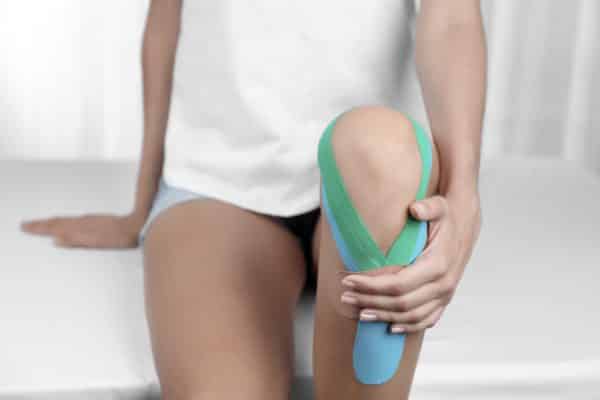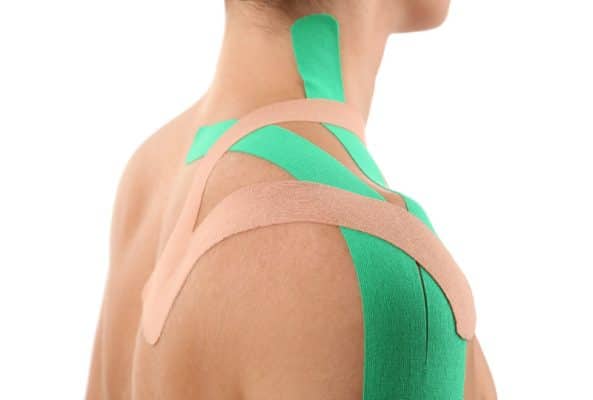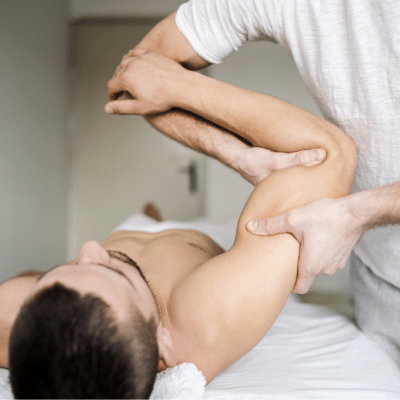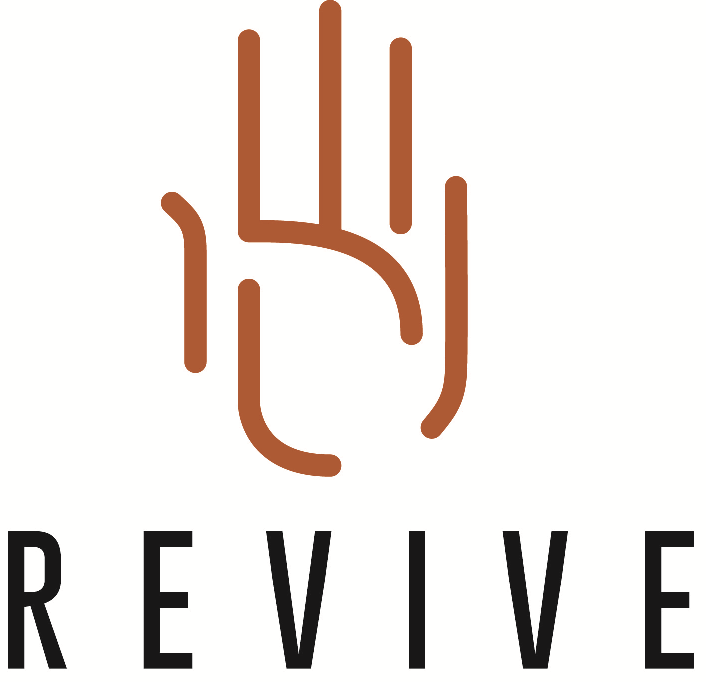Taping Services at Revive Physiotherapy
At Revive Physiotherapy, we offer professional taping services to support recovery, prevent injury and enhance performance. Whether you’re an athlete preparing for competition or someone managing an injury or chronic pain, taping can provide targeted support, stability and comfort where your body needs it most.
Our physiotherapists are trained in both therapeutic taping and sports taping techniques. We’ll assess your individual needs and apply the most suitable method to help you move confidently and safely, whether that’s during your rehabilitation, in daily activities, or on the sports field.

What Is Taping?
Taping involves the precise application of medical-grade adhesive tape by a physiotherapist to support joints and muscles, guide movement, and reduce pain,without fully restricting motion.
There are two main forms of taping:
- Therapeutic taping: often used to aid recovery from injuries, reduce swelling, and improve posture or muscle activation.
- Sports taping: which provides firm support to prevent injury or re-injury during training or competition.
It’s commonly used as a treatment technique in sports physiotherapy, on areas such as the ankles, knees, shoulders, back, neck, feet, elbows, hands, and ribs, offering both protection and comfort during recovery or performance.
Taping isn’t a cure-all, but when combined with a complete treatment plan, including assessment, exercise, hands-on therapy, and load management, it can be an incredibly effective part of your rehabilitation and injury prevention strategy.
At Revive, we use high-quality rigid and elastic tapes and apply them using evidence-based techniques to ensure effective, comfortable, and durable results.
How Does Taping Work?
Taping works by providing gentle external support that helps guide movement, reduce strain, and improve body awareness (proprioception). Depending on your needs, it can:
- Restrict harmful or excessive movement
- Encourage correct alignment and muscle function
- Improve circulation and lymphatic drainage
- Reduce swelling and discomfort
- Support healing tissues as you return to activity
The tape can be worn comfortably for several days, even while showering or exercising, and can be adjusted over time as your condition improves.
Support & Unload
Taping helps offload irritated tissues, stabilise vulnerable joints, and reduce strain so you can move with less pain.
Improve Movement Patterns
It gently guides your body toward better movement mechanics, supporting optimal alignment during healing and sport.
Proprioceptive Feedback
Tape provides a subtle tactile “reminder,” improving your body awareness and control throughout movement.
Swelling & Circulation
Certain tapes create a light lifting effect on the skin, promoting fluid movement and assisting recovery from swelling or bruising.
Improved Confidence
Many people feel safer and more supported when taped, especially when returning to activity after injury.
Types of Taping (and When We Use Them)
Rigid Sports Taping / Strapping Tape

Firm, inelastic sports tape that’s ideal for athletes or active individuals needing firm joint stability, such as those in early rehab or high-risk sports like football and netball. Rigid taping limits harmful movement and protects ligaments or tendons and is commonly used in sports physiotherapy for ankle sprains, AC joint injuries, knees, wrists, shoulders and thumb support.
Kinesiology Tape
A flexible, skin-like support that allows natural movement while providing feedback, assisting circulation, moderating load, reducing swelling, and enhancing recovery. Kinesio taping or elastic taping is often used for shoulder stability, back, muscle pain, calf or hamstring support, and mild strains.
Dynamic Tape
A highly elastic tape that stretches in multiple directions, helping to improve movement patterns and reduce fatigue. Commonly used in running, jumping, or overhead sports, as well as complex shoulder and neurological presentations.
Compression Taping / Wraps
Applied in the early phase after injury or surgery to manage swelling and protect healing tissues. These are usually short-term and reviewed frequently.
Your physiotherapist will select the right tape and technique for your individual needs, explaining how it supports your goals, whether for pain relief, stability, posture, performance, or prevention.
When Taping Helps (Common Conditions & Goals)
Taping is suitable for a wide range of injuries, conditions, and performance goals. It’s often used to help with:
- Acute & Sports Injuries: ankle and knee sprains, shoulder instability or impingement, rib injuries, calf and hamstring strains, tennis elbow.
- Tendon & Overuse Pain: Achilles, patellar, rotator cuff, gluteal, and wrist or forearm tendinopathy.
- Knee Cap (PFJ) & Running Pain: patellofemoral pain, ITB syndrome, shin splints.
- Feet & Lower Limb: plantar fasciitis, heel pain, arch support needs, tibialis posterior issues.
- Back, Neck & Posture: postural retraining or support while you build strength.
- Return to Play & Injury Prevention: extra stability, feedback, and protection during the return-to-sport phase.
Our physiotherapists will discuss your activity level, goals and recovery plan before deciding on the right taping approach for you.
What to Expect at Your Appointment
- Assessment First
 Your physiotherapist will assess your history, movement patterns, and diagnosis to ensure taping is appropriate and effective.
Your physiotherapist will assess your history, movement patterns, and diagnosis to ensure taping is appropriate and effective.
- Personalised Application
We prepare the skin, use hypoallergenic options if needed, and apply the tape with the right tension and placement for your body.
- Test & Refine
You’ll move with the tape on so we can fine-tune comfort and function.
- Plan to Recover
Taping is usually combined with exercise, load guidance, and manual therapy to address the underlying issue.
- Aftercare & Education
We’ll explain how long to leave the tape on (usually 3–5 days for elastic types), how to shower with it, and how to remove it safely. For simple applications, we can teach you how to reapply tape between sessions.
Benefits of Therapeutic Taping
Taping can be a simple but powerful addition to your treatment or recovery program and is most commonly used as a sports physiotherapy treatment technique.
Quicker Pain Relief & More Comfortable Movement
By supporting joints and unloading sensitive tissues, taping can reduce discomfort and make daily movement easier almost immediately.
Stability Without Feeling “Locked Up”
Unlike rigid braces, tape offers support while still allowing natural motion — so you feel stable, not restricted.
Better Control & Confidence Returning to Activity
The extra feedback helps you move with confidence and reduces fear of re-injury.
Reduces Swelling & Protects Healing Tissues
Compression and gentle lift from certain tapes can assist circulation and fluid drainage, speeding recovery.
A Practical Bridge While Strength & Mobility Improve
Taping supports you through early rehab and bridges the gap while strength, coordination, and endurance return.
Safety, Skin Care & When Taping Isn’t Suitable
Your safety and comfort come first. Before taping, we check for:
- Skin sensitivities or allergies
- Fragile or damaged skin
- Open wounds or infections
- Circulation or clotting concerns (e.g. DVT)
If irritation occurs, remove the tape gently, wash and dry the area, and let us know. We have hypoallergenic and sensitive-skin options available.
Taping is always a temporary aid. Your physio will help you move toward long-term recovery through exercise and education.
Why Choose Revive Physiotherapy for Sports Taping
Our sports physiotherapists are highly skilled in evidence-based sports taping techniques and have experience working with a wide range of athletes – from local sporting clubs to recreational fitness enthusiasts.
When you visit Revive, you’ll receive:
- Experienced physiotherapists skilled in rigid, kinesiology, dynamic, and corrective taping techniques.
- One-to-one care with clear explanations, so you understand exactly why and how we’re taping.
- Integrated rehabilitation, combining taping with exercise, manual therapy, and load management to treat a wide range of musculoskeletal conditions.
- Convenient Perth locations with easy booking and friendly support staff ready to help.
We’re here to help you move better, recover faster, and perform at your best.
Locations & Booking
Revive Physiotherapy operates across Perth and regional WA, making it easy to access professional care close to home.
Our taping services are available at our Perth physiotherapy clinics, where your session can be combined with hands-on treatment, joint mobilisations, dry needling, rehabilitation exercises and ongoing recovery support. If you’re working with one of our exercise physiologists, they can also coordinate with our physio team to ensure consistent care and taping where appropriate.
Find your nearest location below and book online today:
Physiotherapy & Taping Available:
Book Your Appointment
Whether you need sports taping, therapeutic taping, or comprehensive physiotherapy treatment, our friendly team is ready to help you move better and recover faster.
Call (08) 9300 0841 or book online at your nearest Revive Physiotherapy clinic.
Frequently Asked Questions
Sports taping uses firm, rigid tape to stabilise joints and prevent injury during movement, while therapeutic taping (such as kinesiology tape) is more elastic, providing gentle support that promotes healing, posture correction and circulation.
Yes. By supporting muscles and reducing strain on joints or soft tissue, taping can relieve discomfort and improve movement. Kinesiology taping also gently lifts the skin, helping to reduce swelling and pressure on pain receptors.
Most tapes can stay on for 3–5 days, depending on your skin type, activity level and the area taped. They are water-resistant and can usually be worn through showers and daily exercise.
Taping is best used as part of a broader treatment plan. It’s a supportive tool that complements physiotherapy, exercise therapy and rehabilitation programs rather than replacing them.
No. Many people benefit from therapeutic taping for pain relief, posture support, and recovery after surgery or injury. It’s suitable for office workers, tradies, and anyone dealing with musculoskeletal issues.
Yes – that’s one of the main benefits! Sports taping provides support and stability while allowing you to continue training or competing safely.
For general support, yes, but for injuries or specific conditions, it’s best to have a physiotherapist apply it first. Incorrect tension or placement can reduce effectiveness or cause skin irritation.
We use high-quality, hypoallergenic tape, but some people with sensitive skin may experience mild irritation. Your physio will discuss options and perform a small test if needed.
Yes, most sports and kinesiology tapes are designed to stay on through moisture and sweat. Gently pat the tape dry afterwards and avoid rubbing.
No, we’ll show you gentle removal techniques and use skin-friendly options to minimise irritation. To remove the tap safely, gently remove in the direction of hair growth, using warm water or oil to loosen the adhesive if needed. Never rip it off quickly, as this can irritate the skin.
If you’ve recently injured yourself, have a chronic pain issue, or need support before a sporting event, a taping session can be a great addition to your physiotherapy or performance routine.
Rigid tape limits risky motion; elastic types allow you to move freely while still providing support. Your physio will choose the best option for your needs.

